ACC8000 Research in Accounting Practice Assignment 3: Finance Report
VerifiedAdded on 2020/05/04
|14
|4739
|48
Report
AI Summary
This report analyzes ACC8000 Assignment 3, focusing on key concepts in financial reporting and accounting practice. The assignment addresses two main questions: the first examines Internet financial reporting by comparing and contrasting the approaches and statistical tests used in studies conducted in different countries. It also explores the advantages and disadvantages of population versus sample-based studies. The second question delves into agency theory, stewardship, and executive compensation. It covers the assumptions of agency theory, its impact on compensation packages, employee attitudes toward risk, and the potential internal problems arising from excessive executive compensation. The report also discusses alternative theories to agency theory, such as stewardship and shareholder theories, and explains their deficiencies in comparison to agency theory. Furthermore, it examines the evolving views of stewardship and the changes in reporting requirements over time.
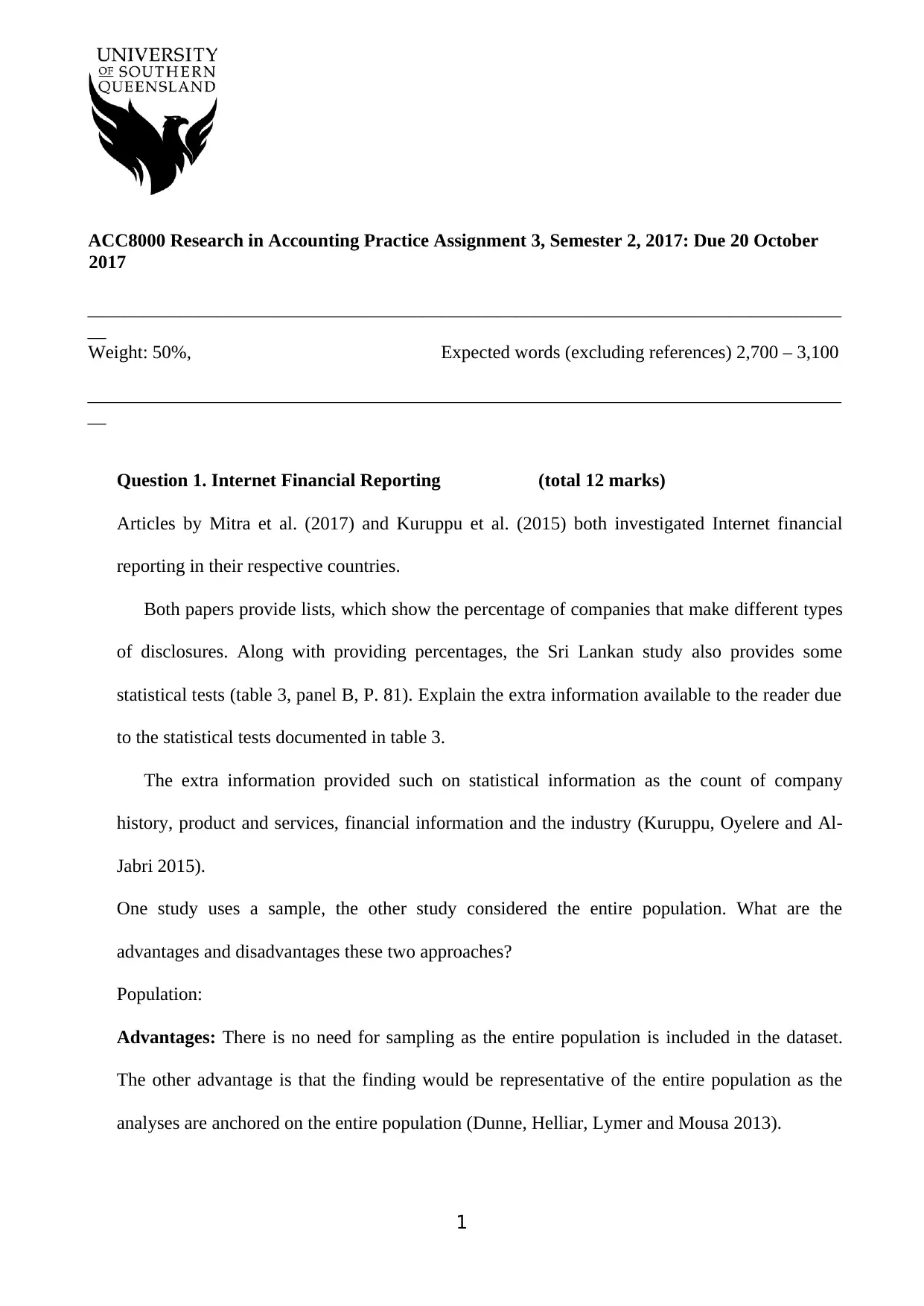
ACC8000 Research in Accounting Practice Assignment 3, Semester 2, 2017: Due 20 October
2017
_________________________________________________________________________________
__
Weight: 50%, Expected words (excluding references) 2,700 – 3,100
_________________________________________________________________________________
__
Question 1. Internet Financial Reporting (total 12 marks)
Articles by Mitra et al. (2017) and Kuruppu et al. (2015) both investigated Internet financial
reporting in their respective countries.
Both papers provide lists, which show the percentage of companies that make different types
of disclosures. Along with providing percentages, the Sri Lankan study also provides some
statistical tests (table 3, panel B, P. 81). Explain the extra information available to the reader due
to the statistical tests documented in table 3.
The extra information provided such on statistical information as the count of company
history, product and services, financial information and the industry (Kuruppu, Oyelere and Al-
Jabri 2015).
One study uses a sample, the other study considered the entire population. What are the
advantages and disadvantages these two approaches?
Population:
Advantages: There is no need for sampling as the entire population is included in the dataset.
The other advantage is that the finding would be representative of the entire population as the
analyses are anchored on the entire population (Dunne, Helliar, Lymer and Mousa 2013).
1
2017
_________________________________________________________________________________
__
Weight: 50%, Expected words (excluding references) 2,700 – 3,100
_________________________________________________________________________________
__
Question 1. Internet Financial Reporting (total 12 marks)
Articles by Mitra et al. (2017) and Kuruppu et al. (2015) both investigated Internet financial
reporting in their respective countries.
Both papers provide lists, which show the percentage of companies that make different types
of disclosures. Along with providing percentages, the Sri Lankan study also provides some
statistical tests (table 3, panel B, P. 81). Explain the extra information available to the reader due
to the statistical tests documented in table 3.
The extra information provided such on statistical information as the count of company
history, product and services, financial information and the industry (Kuruppu, Oyelere and Al-
Jabri 2015).
One study uses a sample, the other study considered the entire population. What are the
advantages and disadvantages these two approaches?
Population:
Advantages: There is no need for sampling as the entire population is included in the dataset.
The other advantage is that the finding would be representative of the entire population as the
analyses are anchored on the entire population (Dunne, Helliar, Lymer and Mousa 2013).
1
Paraphrase This Document
Need a fresh take? Get an instant paraphrase of this document with our AI Paraphraser
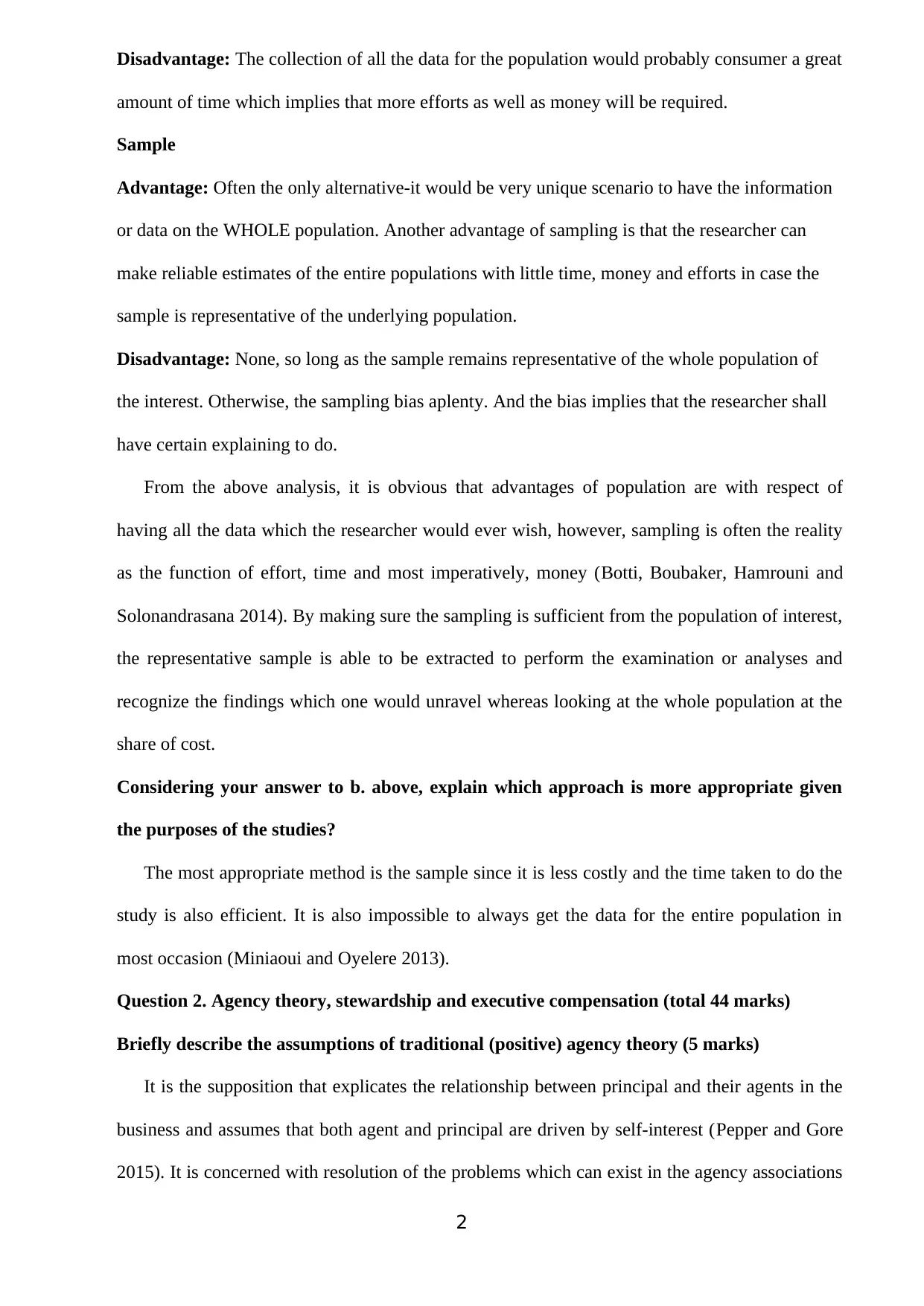
Disadvantage: The collection of all the data for the population would probably consumer a great
amount of time which implies that more efforts as well as money will be required.
Sample
Advantage: Often the only alternative-it would be very unique scenario to have the information
or data on the WHOLE population. Another advantage of sampling is that the researcher can
make reliable estimates of the entire populations with little time, money and efforts in case the
sample is representative of the underlying population.
Disadvantage: None, so long as the sample remains representative of the whole population of
the interest. Otherwise, the sampling bias aplenty. And the bias implies that the researcher shall
have certain explaining to do.
From the above analysis, it is obvious that advantages of population are with respect of
having all the data which the researcher would ever wish, however, sampling is often the reality
as the function of effort, time and most imperatively, money (Botti, Boubaker, Hamrouni and
Solonandrasana 2014). By making sure the sampling is sufficient from the population of interest,
the representative sample is able to be extracted to perform the examination or analyses and
recognize the findings which one would unravel whereas looking at the whole population at the
share of cost.
Considering your answer to b. above, explain which approach is more appropriate given
the purposes of the studies?
The most appropriate method is the sample since it is less costly and the time taken to do the
study is also efficient. It is also impossible to always get the data for the entire population in
most occasion (Miniaoui and Oyelere 2013).
Question 2. Agency theory, stewardship and executive compensation (total 44 marks)
Briefly describe the assumptions of traditional (positive) agency theory (5 marks)
It is the supposition that explicates the relationship between principal and their agents in the
business and assumes that both agent and principal are driven by self-interest (Pepper and Gore
2015). It is concerned with resolution of the problems which can exist in the agency associations
2
amount of time which implies that more efforts as well as money will be required.
Sample
Advantage: Often the only alternative-it would be very unique scenario to have the information
or data on the WHOLE population. Another advantage of sampling is that the researcher can
make reliable estimates of the entire populations with little time, money and efforts in case the
sample is representative of the underlying population.
Disadvantage: None, so long as the sample remains representative of the whole population of
the interest. Otherwise, the sampling bias aplenty. And the bias implies that the researcher shall
have certain explaining to do.
From the above analysis, it is obvious that advantages of population are with respect of
having all the data which the researcher would ever wish, however, sampling is often the reality
as the function of effort, time and most imperatively, money (Botti, Boubaker, Hamrouni and
Solonandrasana 2014). By making sure the sampling is sufficient from the population of interest,
the representative sample is able to be extracted to perform the examination or analyses and
recognize the findings which one would unravel whereas looking at the whole population at the
share of cost.
Considering your answer to b. above, explain which approach is more appropriate given
the purposes of the studies?
The most appropriate method is the sample since it is less costly and the time taken to do the
study is also efficient. It is also impossible to always get the data for the entire population in
most occasion (Miniaoui and Oyelere 2013).
Question 2. Agency theory, stewardship and executive compensation (total 44 marks)
Briefly describe the assumptions of traditional (positive) agency theory (5 marks)
It is the supposition that explicates the relationship between principal and their agents in the
business and assumes that both agent and principal are driven by self-interest (Pepper and Gore
2015). It is concerned with resolution of the problems which can exist in the agency associations
2
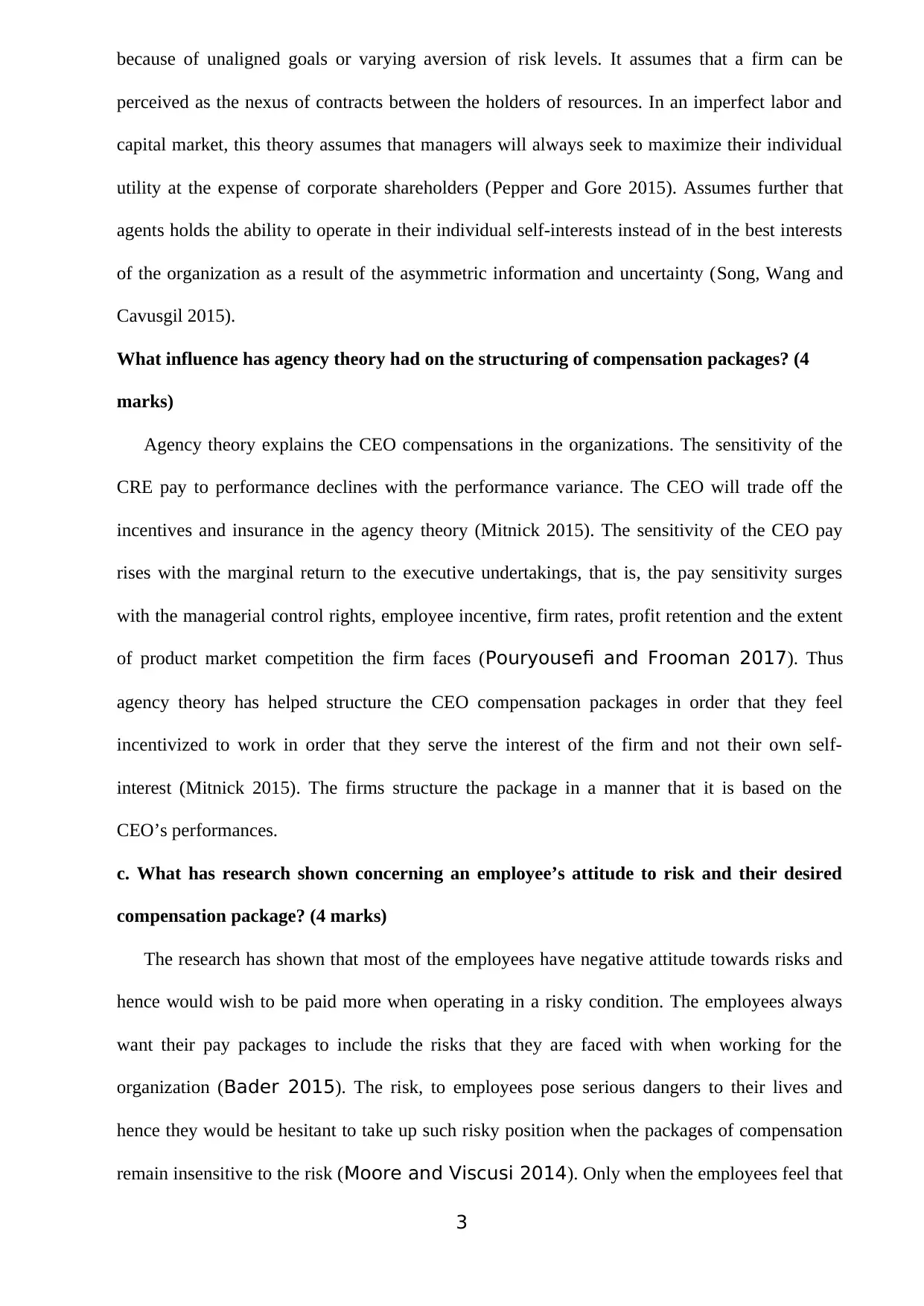
because of unaligned goals or varying aversion of risk levels. It assumes that a firm can be
perceived as the nexus of contracts between the holders of resources. In an imperfect labor and
capital market, this theory assumes that managers will always seek to maximize their individual
utility at the expense of corporate shareholders (Pepper and Gore 2015). Assumes further that
agents holds the ability to operate in their individual self-interests instead of in the best interests
of the organization as a result of the asymmetric information and uncertainty (Song, Wang and
Cavusgil 2015).
What influence has agency theory had on the structuring of compensation packages? (4
marks)
Agency theory explains the CEO compensations in the organizations. The sensitivity of the
CRE pay to performance declines with the performance variance. The CEO will trade off the
incentives and insurance in the agency theory (Mitnick 2015). The sensitivity of the CEO pay
rises with the marginal return to the executive undertakings, that is, the pay sensitivity surges
with the managerial control rights, employee incentive, firm rates, profit retention and the extent
of product market competition the firm faces (Pouryousefi and Frooman 2017). Thus
agency theory has helped structure the CEO compensation packages in order that they feel
incentivized to work in order that they serve the interest of the firm and not their own self-
interest (Mitnick 2015). The firms structure the package in a manner that it is based on the
CEO’s performances.
c. What has research shown concerning an employee’s attitude to risk and their desired
compensation package? (4 marks)
The research has shown that most of the employees have negative attitude towards risks and
hence would wish to be paid more when operating in a risky condition. The employees always
want their pay packages to include the risks that they are faced with when working for the
organization (Bader 2015). The risk, to employees pose serious dangers to their lives and
hence they would be hesitant to take up such risky position when the packages of compensation
remain insensitive to the risk (Moore and Viscusi 2014). Only when the employees feel that
3
perceived as the nexus of contracts between the holders of resources. In an imperfect labor and
capital market, this theory assumes that managers will always seek to maximize their individual
utility at the expense of corporate shareholders (Pepper and Gore 2015). Assumes further that
agents holds the ability to operate in their individual self-interests instead of in the best interests
of the organization as a result of the asymmetric information and uncertainty (Song, Wang and
Cavusgil 2015).
What influence has agency theory had on the structuring of compensation packages? (4
marks)
Agency theory explains the CEO compensations in the organizations. The sensitivity of the
CRE pay to performance declines with the performance variance. The CEO will trade off the
incentives and insurance in the agency theory (Mitnick 2015). The sensitivity of the CEO pay
rises with the marginal return to the executive undertakings, that is, the pay sensitivity surges
with the managerial control rights, employee incentive, firm rates, profit retention and the extent
of product market competition the firm faces (Pouryousefi and Frooman 2017). Thus
agency theory has helped structure the CEO compensation packages in order that they feel
incentivized to work in order that they serve the interest of the firm and not their own self-
interest (Mitnick 2015). The firms structure the package in a manner that it is based on the
CEO’s performances.
c. What has research shown concerning an employee’s attitude to risk and their desired
compensation package? (4 marks)
The research has shown that most of the employees have negative attitude towards risks and
hence would wish to be paid more when operating in a risky condition. The employees always
want their pay packages to include the risks that they are faced with when working for the
organization (Bader 2015). The risk, to employees pose serious dangers to their lives and
hence they would be hesitant to take up such risky position when the packages of compensation
remain insensitive to the risk (Moore and Viscusi 2014). Only when the employees feel that
3
⊘ This is a preview!⊘
Do you want full access?
Subscribe today to unlock all pages.

Trusted by 1+ million students worldwide
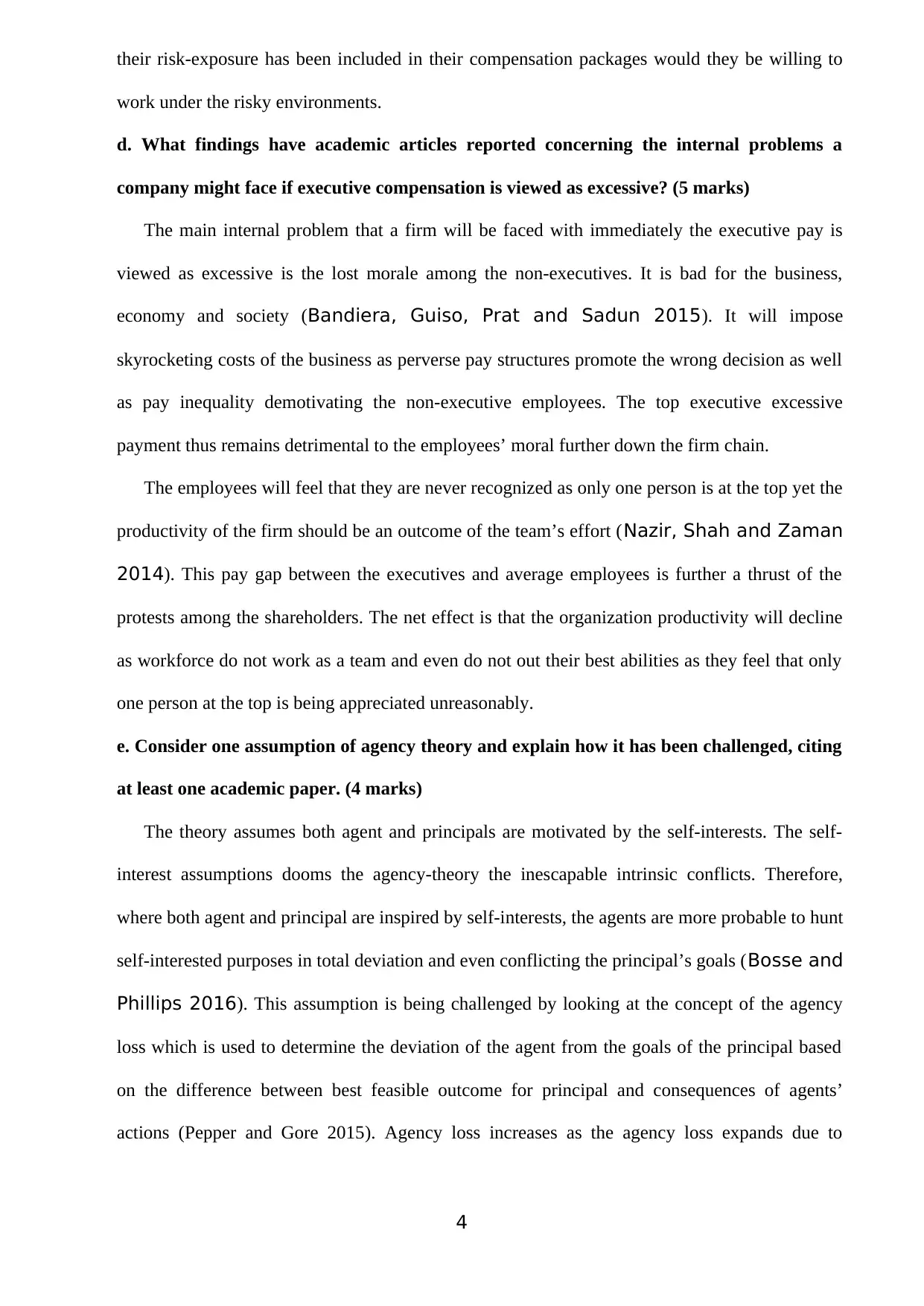
their risk-exposure has been included in their compensation packages would they be willing to
work under the risky environments.
d. What findings have academic articles reported concerning the internal problems a
company might face if executive compensation is viewed as excessive? (5 marks)
The main internal problem that a firm will be faced with immediately the executive pay is
viewed as excessive is the lost morale among the non-executives. It is bad for the business,
economy and society (Bandiera, Guiso, Prat and Sadun 2015). It will impose
skyrocketing costs of the business as perverse pay structures promote the wrong decision as well
as pay inequality demotivating the non-executive employees. The top executive excessive
payment thus remains detrimental to the employees’ moral further down the firm chain.
The employees will feel that they are never recognized as only one person is at the top yet the
productivity of the firm should be an outcome of the team’s effort (Nazir, Shah and Zaman
2014). This pay gap between the executives and average employees is further a thrust of the
protests among the shareholders. The net effect is that the organization productivity will decline
as workforce do not work as a team and even do not out their best abilities as they feel that only
one person at the top is being appreciated unreasonably.
e. Consider one assumption of agency theory and explain how it has been challenged, citing
at least one academic paper. (4 marks)
The theory assumes both agent and principals are motivated by the self-interests. The self-
interest assumptions dooms the agency-theory the inescapable intrinsic conflicts. Therefore,
where both agent and principal are inspired by self-interests, the agents are more probable to hunt
self-interested purposes in total deviation and even conflicting the principal’s goals (Bosse and
Phillips 2016). This assumption is being challenged by looking at the concept of the agency
loss which is used to determine the deviation of the agent from the goals of the principal based
on the difference between best feasible outcome for principal and consequences of agents’
actions (Pepper and Gore 2015). Agency loss increases as the agency loss expands due to
4
work under the risky environments.
d. What findings have academic articles reported concerning the internal problems a
company might face if executive compensation is viewed as excessive? (5 marks)
The main internal problem that a firm will be faced with immediately the executive pay is
viewed as excessive is the lost morale among the non-executives. It is bad for the business,
economy and society (Bandiera, Guiso, Prat and Sadun 2015). It will impose
skyrocketing costs of the business as perverse pay structures promote the wrong decision as well
as pay inequality demotivating the non-executive employees. The top executive excessive
payment thus remains detrimental to the employees’ moral further down the firm chain.
The employees will feel that they are never recognized as only one person is at the top yet the
productivity of the firm should be an outcome of the team’s effort (Nazir, Shah and Zaman
2014). This pay gap between the executives and average employees is further a thrust of the
protests among the shareholders. The net effect is that the organization productivity will decline
as workforce do not work as a team and even do not out their best abilities as they feel that only
one person at the top is being appreciated unreasonably.
e. Consider one assumption of agency theory and explain how it has been challenged, citing
at least one academic paper. (4 marks)
The theory assumes both agent and principals are motivated by the self-interests. The self-
interest assumptions dooms the agency-theory the inescapable intrinsic conflicts. Therefore,
where both agent and principal are inspired by self-interests, the agents are more probable to hunt
self-interested purposes in total deviation and even conflicting the principal’s goals (Bosse and
Phillips 2016). This assumption is being challenged by looking at the concept of the agency
loss which is used to determine the deviation of the agent from the goals of the principal based
on the difference between best feasible outcome for principal and consequences of agents’
actions (Pepper and Gore 2015). Agency loss increases as the agency loss expands due to
4
Paraphrase This Document
Need a fresh take? Get an instant paraphrase of this document with our AI Paraphraser
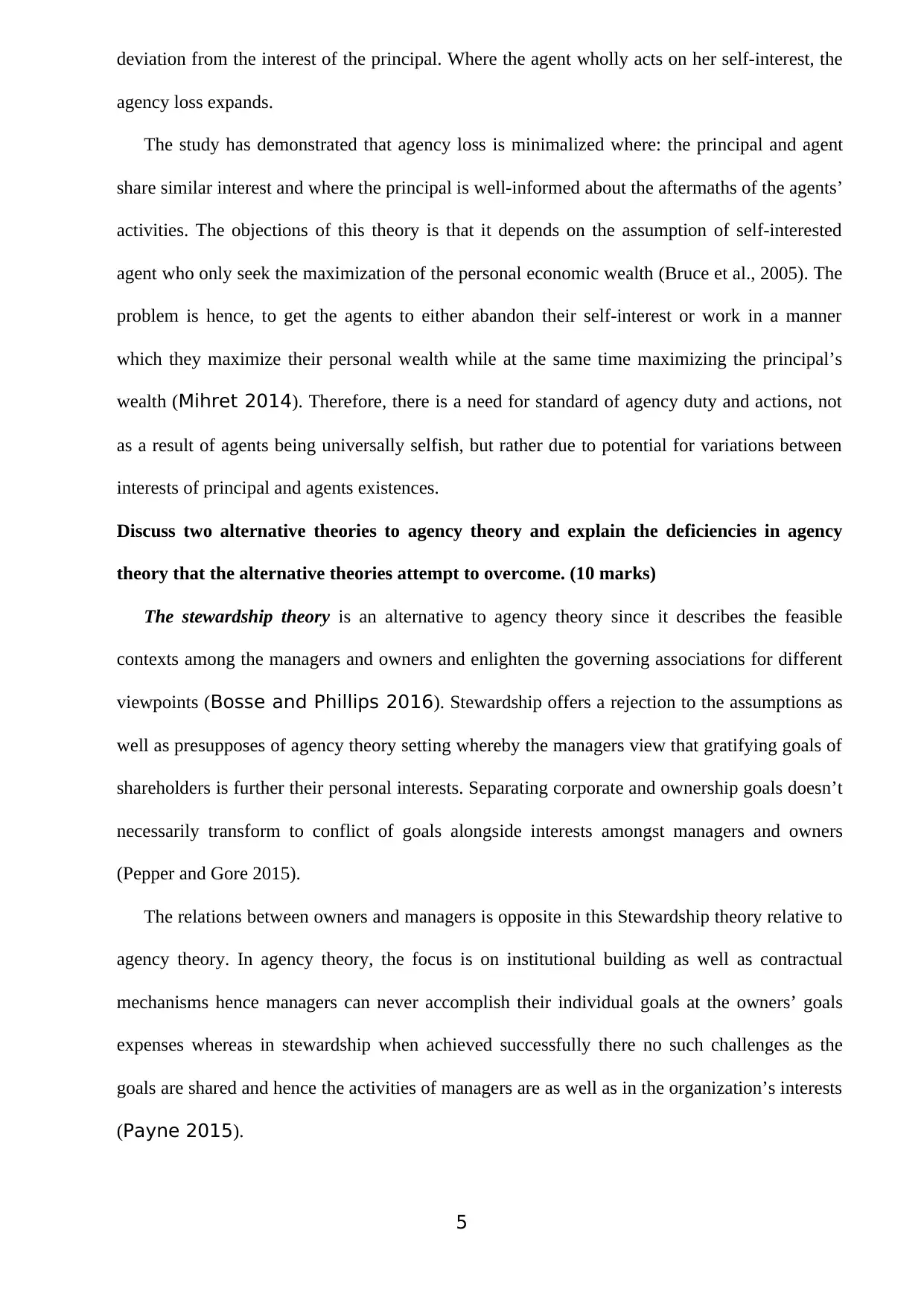
deviation from the interest of the principal. Where the agent wholly acts on her self-interest, the
agency loss expands.
The study has demonstrated that agency loss is minimalized where: the principal and agent
share similar interest and where the principal is well-informed about the aftermaths of the agents’
activities. The objections of this theory is that it depends on the assumption of self-interested
agent who only seek the maximization of the personal economic wealth (Bruce et al., 2005). The
problem is hence, to get the agents to either abandon their self-interest or work in a manner
which they maximize their personal wealth while at the same time maximizing the principal’s
wealth (Mihret 2014). Therefore, there is a need for standard of agency duty and actions, not
as a result of agents being universally selfish, but rather due to potential for variations between
interests of principal and agents existences.
Discuss two alternative theories to agency theory and explain the deficiencies in agency
theory that the alternative theories attempt to overcome. (10 marks)
The stewardship theory is an alternative to agency theory since it describes the feasible
contexts among the managers and owners and enlighten the governing associations for different
viewpoints (Bosse and Phillips 2016). Stewardship offers a rejection to the assumptions as
well as presupposes of agency theory setting whereby the managers view that gratifying goals of
shareholders is further their personal interests. Separating corporate and ownership goals doesn’t
necessarily transform to conflict of goals alongside interests amongst managers and owners
(Pepper and Gore 2015).
The relations between owners and managers is opposite in this Stewardship theory relative to
agency theory. In agency theory, the focus is on institutional building as well as contractual
mechanisms hence managers can never accomplish their individual goals at the owners’ goals
expenses whereas in stewardship when achieved successfully there no such challenges as the
goals are shared and hence the activities of managers are as well as in the organization’s interests
(Payne 2015).
5
agency loss expands.
The study has demonstrated that agency loss is minimalized where: the principal and agent
share similar interest and where the principal is well-informed about the aftermaths of the agents’
activities. The objections of this theory is that it depends on the assumption of self-interested
agent who only seek the maximization of the personal economic wealth (Bruce et al., 2005). The
problem is hence, to get the agents to either abandon their self-interest or work in a manner
which they maximize their personal wealth while at the same time maximizing the principal’s
wealth (Mihret 2014). Therefore, there is a need for standard of agency duty and actions, not
as a result of agents being universally selfish, but rather due to potential for variations between
interests of principal and agents existences.
Discuss two alternative theories to agency theory and explain the deficiencies in agency
theory that the alternative theories attempt to overcome. (10 marks)
The stewardship theory is an alternative to agency theory since it describes the feasible
contexts among the managers and owners and enlighten the governing associations for different
viewpoints (Bosse and Phillips 2016). Stewardship offers a rejection to the assumptions as
well as presupposes of agency theory setting whereby the managers view that gratifying goals of
shareholders is further their personal interests. Separating corporate and ownership goals doesn’t
necessarily transform to conflict of goals alongside interests amongst managers and owners
(Pepper and Gore 2015).
The relations between owners and managers is opposite in this Stewardship theory relative to
agency theory. In agency theory, the focus is on institutional building as well as contractual
mechanisms hence managers can never accomplish their individual goals at the owners’ goals
expenses whereas in stewardship when achieved successfully there no such challenges as the
goals are shared and hence the activities of managers are as well as in the organization’s interests
(Payne 2015).
5
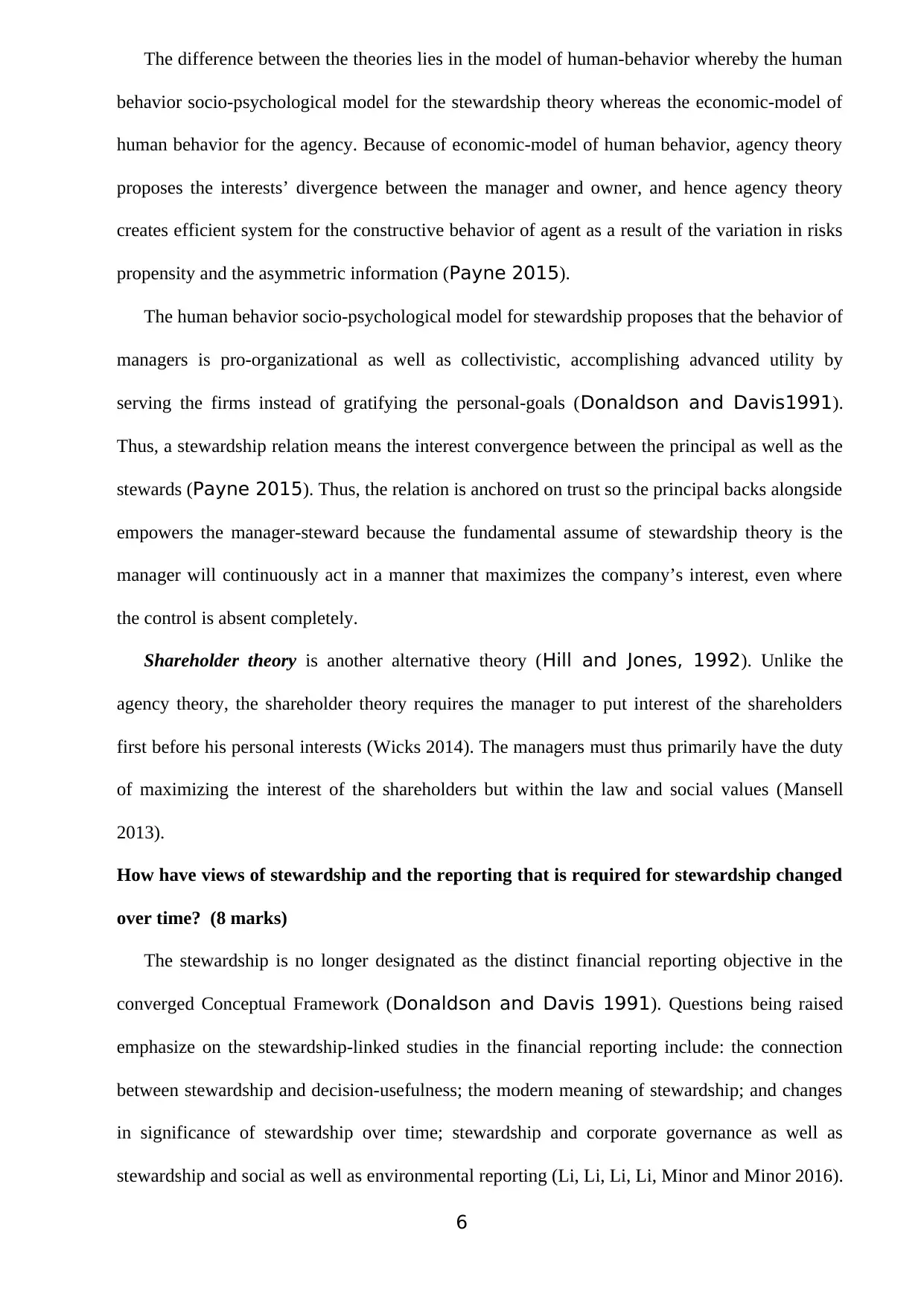
The difference between the theories lies in the model of human-behavior whereby the human
behavior socio-psychological model for the stewardship theory whereas the economic-model of
human behavior for the agency. Because of economic-model of human behavior, agency theory
proposes the interests’ divergence between the manager and owner, and hence agency theory
creates efficient system for the constructive behavior of agent as a result of the variation in risks
propensity and the asymmetric information (Payne 2015).
The human behavior socio-psychological model for stewardship proposes that the behavior of
managers is pro-organizational as well as collectivistic, accomplishing advanced utility by
serving the firms instead of gratifying the personal-goals (Donaldson and Davis1991).
Thus, a stewardship relation means the interest convergence between the principal as well as the
stewards (Payne 2015). Thus, the relation is anchored on trust so the principal backs alongside
empowers the manager-steward because the fundamental assume of stewardship theory is the
manager will continuously act in a manner that maximizes the company’s interest, even where
the control is absent completely.
Shareholder theory is another alternative theory (Hill and Jones, 1992). Unlike the
agency theory, the shareholder theory requires the manager to put interest of the shareholders
first before his personal interests (Wicks 2014). The managers must thus primarily have the duty
of maximizing the interest of the shareholders but within the law and social values (Mansell
2013).
How have views of stewardship and the reporting that is required for stewardship changed
over time? (8 marks)
The stewardship is no longer designated as the distinct financial reporting objective in the
converged Conceptual Framework (Donaldson and Davis 1991). Questions being raised
emphasize on the stewardship-linked studies in the financial reporting include: the connection
between stewardship and decision-usefulness; the modern meaning of stewardship; and changes
in significance of stewardship over time; stewardship and corporate governance as well as
stewardship and social as well as environmental reporting (Li, Li, Li, Li, Minor and Minor 2016).
6
behavior socio-psychological model for the stewardship theory whereas the economic-model of
human behavior for the agency. Because of economic-model of human behavior, agency theory
proposes the interests’ divergence between the manager and owner, and hence agency theory
creates efficient system for the constructive behavior of agent as a result of the variation in risks
propensity and the asymmetric information (Payne 2015).
The human behavior socio-psychological model for stewardship proposes that the behavior of
managers is pro-organizational as well as collectivistic, accomplishing advanced utility by
serving the firms instead of gratifying the personal-goals (Donaldson and Davis1991).
Thus, a stewardship relation means the interest convergence between the principal as well as the
stewards (Payne 2015). Thus, the relation is anchored on trust so the principal backs alongside
empowers the manager-steward because the fundamental assume of stewardship theory is the
manager will continuously act in a manner that maximizes the company’s interest, even where
the control is absent completely.
Shareholder theory is another alternative theory (Hill and Jones, 1992). Unlike the
agency theory, the shareholder theory requires the manager to put interest of the shareholders
first before his personal interests (Wicks 2014). The managers must thus primarily have the duty
of maximizing the interest of the shareholders but within the law and social values (Mansell
2013).
How have views of stewardship and the reporting that is required for stewardship changed
over time? (8 marks)
The stewardship is no longer designated as the distinct financial reporting objective in the
converged Conceptual Framework (Donaldson and Davis 1991). Questions being raised
emphasize on the stewardship-linked studies in the financial reporting include: the connection
between stewardship and decision-usefulness; the modern meaning of stewardship; and changes
in significance of stewardship over time; stewardship and corporate governance as well as
stewardship and social as well as environmental reporting (Li, Li, Li, Li, Minor and Minor 2016).
6
⊘ This is a preview!⊘
Do you want full access?
Subscribe today to unlock all pages.

Trusted by 1+ million students worldwide
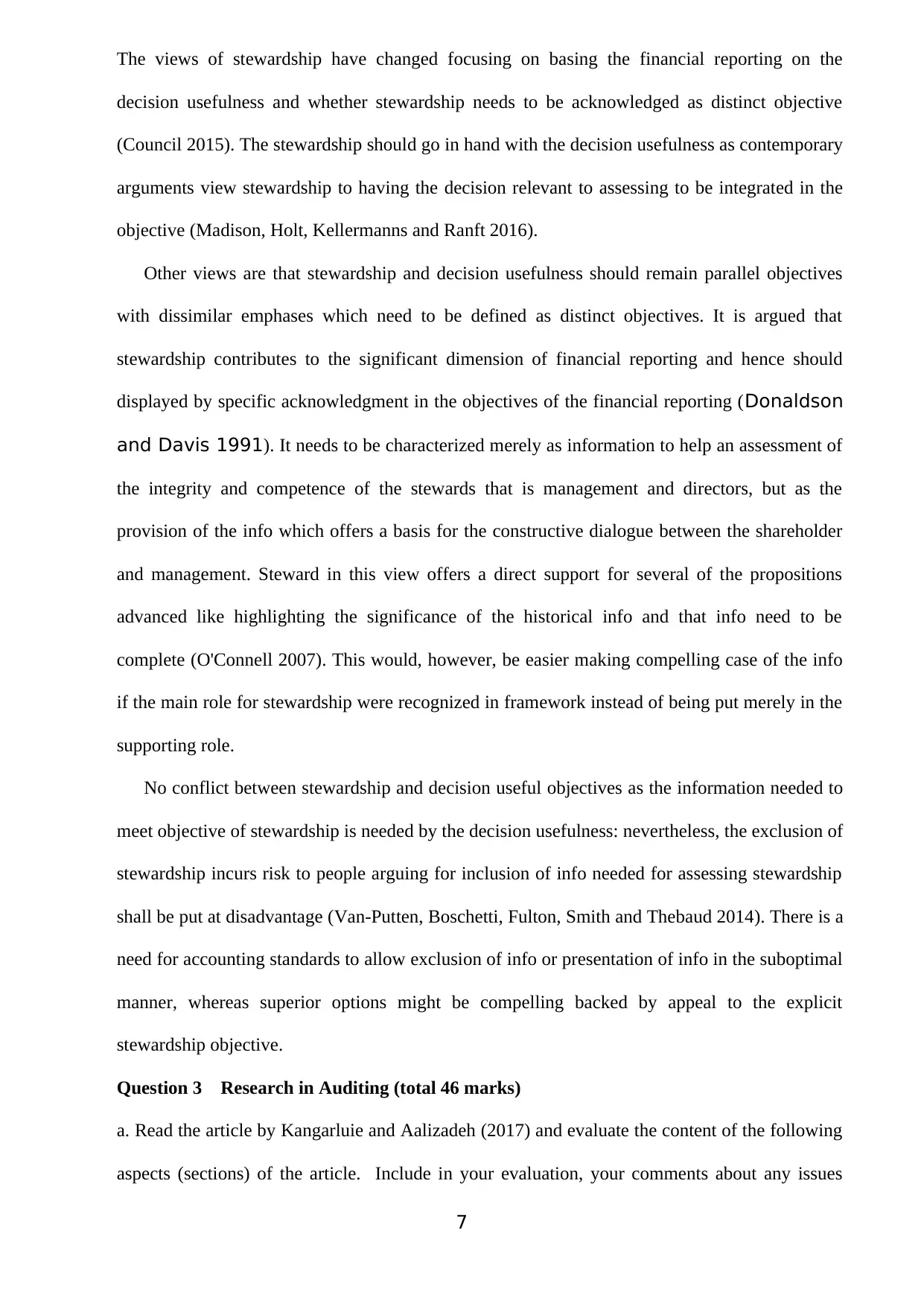
The views of stewardship have changed focusing on basing the financial reporting on the
decision usefulness and whether stewardship needs to be acknowledged as distinct objective
(Council 2015). The stewardship should go in hand with the decision usefulness as contemporary
arguments view stewardship to having the decision relevant to assessing to be integrated in the
objective (Madison, Holt, Kellermanns and Ranft 2016).
Other views are that stewardship and decision usefulness should remain parallel objectives
with dissimilar emphases which need to be defined as distinct objectives. It is argued that
stewardship contributes to the significant dimension of financial reporting and hence should
displayed by specific acknowledgment in the objectives of the financial reporting (Donaldson
and Davis 1991). It needs to be characterized merely as information to help an assessment of
the integrity and competence of the stewards that is management and directors, but as the
provision of the info which offers a basis for the constructive dialogue between the shareholder
and management. Steward in this view offers a direct support for several of the propositions
advanced like highlighting the significance of the historical info and that info need to be
complete (O'Connell 2007). This would, however, be easier making compelling case of the info
if the main role for stewardship were recognized in framework instead of being put merely in the
supporting role.
No conflict between stewardship and decision useful objectives as the information needed to
meet objective of stewardship is needed by the decision usefulness: nevertheless, the exclusion of
stewardship incurs risk to people arguing for inclusion of info needed for assessing stewardship
shall be put at disadvantage (Van-Putten, Boschetti, Fulton, Smith and Thebaud 2014). There is a
need for accounting standards to allow exclusion of info or presentation of info in the suboptimal
manner, whereas superior options might be compelling backed by appeal to the explicit
stewardship objective.
Question 3 Research in Auditing (total 46 marks)
a. Read the article by Kangarluie and Aalizadeh (2017) and evaluate the content of the following
aspects (sections) of the article. Include in your evaluation, your comments about any issues
7
decision usefulness and whether stewardship needs to be acknowledged as distinct objective
(Council 2015). The stewardship should go in hand with the decision usefulness as contemporary
arguments view stewardship to having the decision relevant to assessing to be integrated in the
objective (Madison, Holt, Kellermanns and Ranft 2016).
Other views are that stewardship and decision usefulness should remain parallel objectives
with dissimilar emphases which need to be defined as distinct objectives. It is argued that
stewardship contributes to the significant dimension of financial reporting and hence should
displayed by specific acknowledgment in the objectives of the financial reporting (Donaldson
and Davis 1991). It needs to be characterized merely as information to help an assessment of
the integrity and competence of the stewards that is management and directors, but as the
provision of the info which offers a basis for the constructive dialogue between the shareholder
and management. Steward in this view offers a direct support for several of the propositions
advanced like highlighting the significance of the historical info and that info need to be
complete (O'Connell 2007). This would, however, be easier making compelling case of the info
if the main role for stewardship were recognized in framework instead of being put merely in the
supporting role.
No conflict between stewardship and decision useful objectives as the information needed to
meet objective of stewardship is needed by the decision usefulness: nevertheless, the exclusion of
stewardship incurs risk to people arguing for inclusion of info needed for assessing stewardship
shall be put at disadvantage (Van-Putten, Boschetti, Fulton, Smith and Thebaud 2014). There is a
need for accounting standards to allow exclusion of info or presentation of info in the suboptimal
manner, whereas superior options might be compelling backed by appeal to the explicit
stewardship objective.
Question 3 Research in Auditing (total 46 marks)
a. Read the article by Kangarluie and Aalizadeh (2017) and evaluate the content of the following
aspects (sections) of the article. Include in your evaluation, your comments about any issues
7
Paraphrase This Document
Need a fresh take? Get an instant paraphrase of this document with our AI Paraphraser
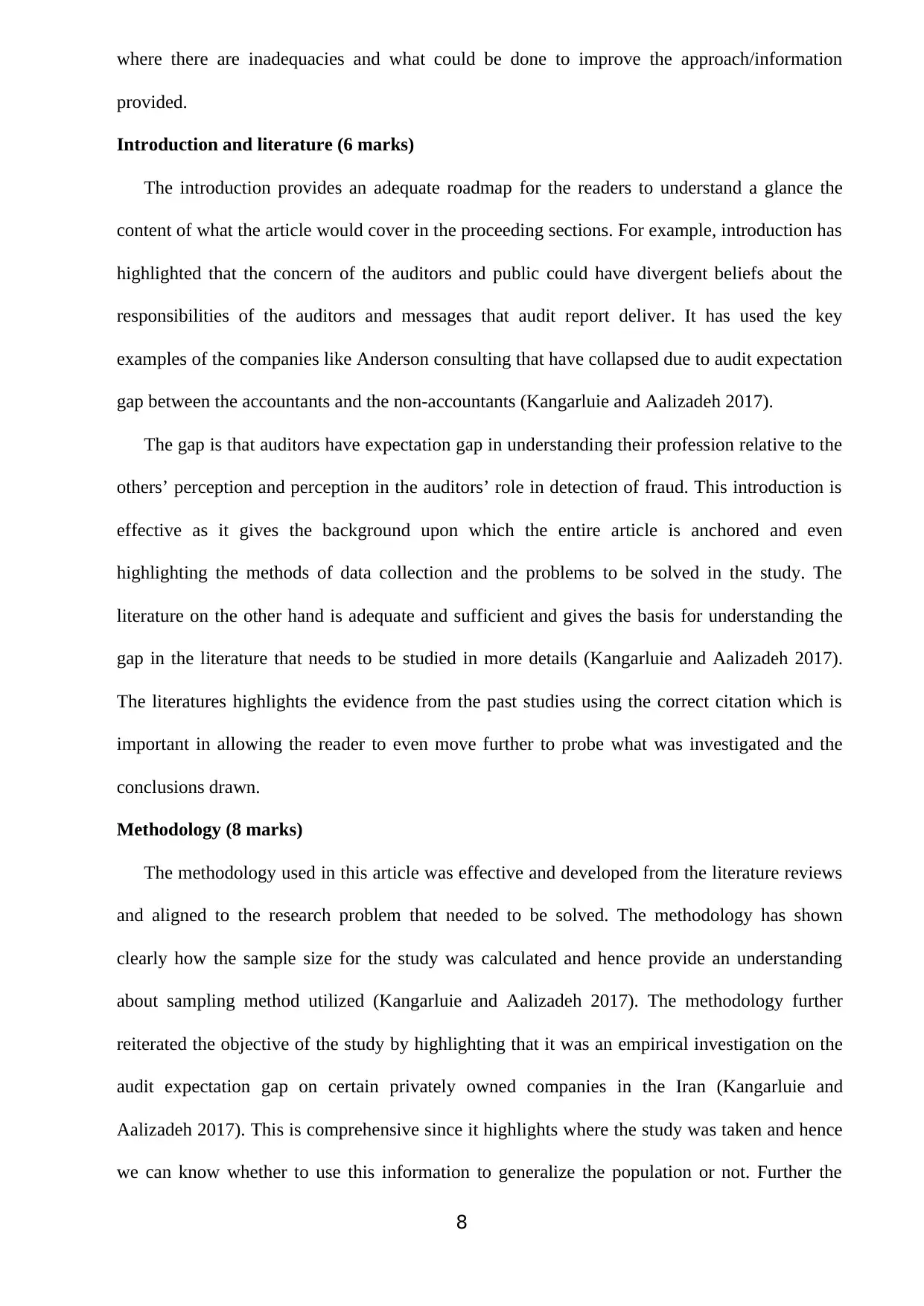
where there are inadequacies and what could be done to improve the approach/information
provided.
Introduction and literature (6 marks)
The introduction provides an adequate roadmap for the readers to understand a glance the
content of what the article would cover in the proceeding sections. For example, introduction has
highlighted that the concern of the auditors and public could have divergent beliefs about the
responsibilities of the auditors and messages that audit report deliver. It has used the key
examples of the companies like Anderson consulting that have collapsed due to audit expectation
gap between the accountants and the non-accountants (Kangarluie and Aalizadeh 2017).
The gap is that auditors have expectation gap in understanding their profession relative to the
others’ perception and perception in the auditors’ role in detection of fraud. This introduction is
effective as it gives the background upon which the entire article is anchored and even
highlighting the methods of data collection and the problems to be solved in the study. The
literature on the other hand is adequate and sufficient and gives the basis for understanding the
gap in the literature that needs to be studied in more details (Kangarluie and Aalizadeh 2017).
The literatures highlights the evidence from the past studies using the correct citation which is
important in allowing the reader to even move further to probe what was investigated and the
conclusions drawn.
Methodology (8 marks)
The methodology used in this article was effective and developed from the literature reviews
and aligned to the research problem that needed to be solved. The methodology has shown
clearly how the sample size for the study was calculated and hence provide an understanding
about sampling method utilized (Kangarluie and Aalizadeh 2017). The methodology further
reiterated the objective of the study by highlighting that it was an empirical investigation on the
audit expectation gap on certain privately owned companies in the Iran (Kangarluie and
Aalizadeh 2017). This is comprehensive since it highlights where the study was taken and hence
we can know whether to use this information to generalize the population or not. Further the
8
provided.
Introduction and literature (6 marks)
The introduction provides an adequate roadmap for the readers to understand a glance the
content of what the article would cover in the proceeding sections. For example, introduction has
highlighted that the concern of the auditors and public could have divergent beliefs about the
responsibilities of the auditors and messages that audit report deliver. It has used the key
examples of the companies like Anderson consulting that have collapsed due to audit expectation
gap between the accountants and the non-accountants (Kangarluie and Aalizadeh 2017).
The gap is that auditors have expectation gap in understanding their profession relative to the
others’ perception and perception in the auditors’ role in detection of fraud. This introduction is
effective as it gives the background upon which the entire article is anchored and even
highlighting the methods of data collection and the problems to be solved in the study. The
literature on the other hand is adequate and sufficient and gives the basis for understanding the
gap in the literature that needs to be studied in more details (Kangarluie and Aalizadeh 2017).
The literatures highlights the evidence from the past studies using the correct citation which is
important in allowing the reader to even move further to probe what was investigated and the
conclusions drawn.
Methodology (8 marks)
The methodology used in this article was effective and developed from the literature reviews
and aligned to the research problem that needed to be solved. The methodology has shown
clearly how the sample size for the study was calculated and hence provide an understanding
about sampling method utilized (Kangarluie and Aalizadeh 2017). The methodology further
reiterated the objective of the study by highlighting that it was an empirical investigation on the
audit expectation gap on certain privately owned companies in the Iran (Kangarluie and
Aalizadeh 2017). This is comprehensive since it highlights where the study was taken and hence
we can know whether to use this information to generalize the population or not. Further the
8
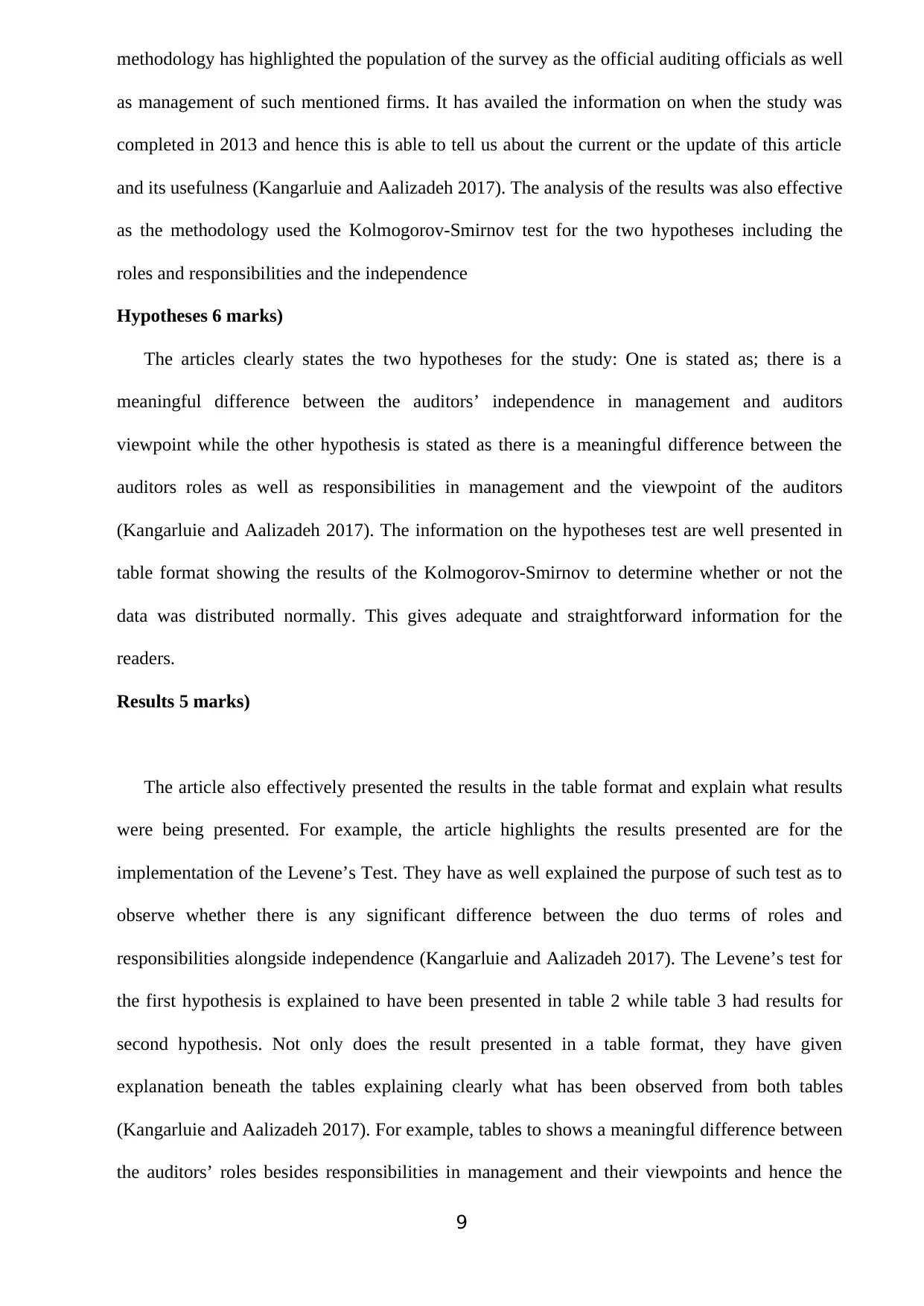
methodology has highlighted the population of the survey as the official auditing officials as well
as management of such mentioned firms. It has availed the information on when the study was
completed in 2013 and hence this is able to tell us about the current or the update of this article
and its usefulness (Kangarluie and Aalizadeh 2017). The analysis of the results was also effective
as the methodology used the Kolmogorov-Smirnov test for the two hypotheses including the
roles and responsibilities and the independence
Hypotheses 6 marks)
The articles clearly states the two hypotheses for the study: One is stated as; there is a
meaningful difference between the auditors’ independence in management and auditors
viewpoint while the other hypothesis is stated as there is a meaningful difference between the
auditors roles as well as responsibilities in management and the viewpoint of the auditors
(Kangarluie and Aalizadeh 2017). The information on the hypotheses test are well presented in
table format showing the results of the Kolmogorov-Smirnov to determine whether or not the
data was distributed normally. This gives adequate and straightforward information for the
readers.
Results 5 marks)
The article also effectively presented the results in the table format and explain what results
were being presented. For example, the article highlights the results presented are for the
implementation of the Levene’s Test. They have as well explained the purpose of such test as to
observe whether there is any significant difference between the duo terms of roles and
responsibilities alongside independence (Kangarluie and Aalizadeh 2017). The Levene’s test for
the first hypothesis is explained to have been presented in table 2 while table 3 had results for
second hypothesis. Not only does the result presented in a table format, they have given
explanation beneath the tables explaining clearly what has been observed from both tables
(Kangarluie and Aalizadeh 2017). For example, tables to shows a meaningful difference between
the auditors’ roles besides responsibilities in management and their viewpoints and hence the
9
as management of such mentioned firms. It has availed the information on when the study was
completed in 2013 and hence this is able to tell us about the current or the update of this article
and its usefulness (Kangarluie and Aalizadeh 2017). The analysis of the results was also effective
as the methodology used the Kolmogorov-Smirnov test for the two hypotheses including the
roles and responsibilities and the independence
Hypotheses 6 marks)
The articles clearly states the two hypotheses for the study: One is stated as; there is a
meaningful difference between the auditors’ independence in management and auditors
viewpoint while the other hypothesis is stated as there is a meaningful difference between the
auditors roles as well as responsibilities in management and the viewpoint of the auditors
(Kangarluie and Aalizadeh 2017). The information on the hypotheses test are well presented in
table format showing the results of the Kolmogorov-Smirnov to determine whether or not the
data was distributed normally. This gives adequate and straightforward information for the
readers.
Results 5 marks)
The article also effectively presented the results in the table format and explain what results
were being presented. For example, the article highlights the results presented are for the
implementation of the Levene’s Test. They have as well explained the purpose of such test as to
observe whether there is any significant difference between the duo terms of roles and
responsibilities alongside independence (Kangarluie and Aalizadeh 2017). The Levene’s test for
the first hypothesis is explained to have been presented in table 2 while table 3 had results for
second hypothesis. Not only does the result presented in a table format, they have given
explanation beneath the tables explaining clearly what has been observed from both tables
(Kangarluie and Aalizadeh 2017). For example, tables to shows a meaningful difference between
the auditors’ roles besides responsibilities in management and their viewpoints and hence the
9
⊘ This is a preview!⊘
Do you want full access?
Subscribe today to unlock all pages.

Trusted by 1+ million students worldwide
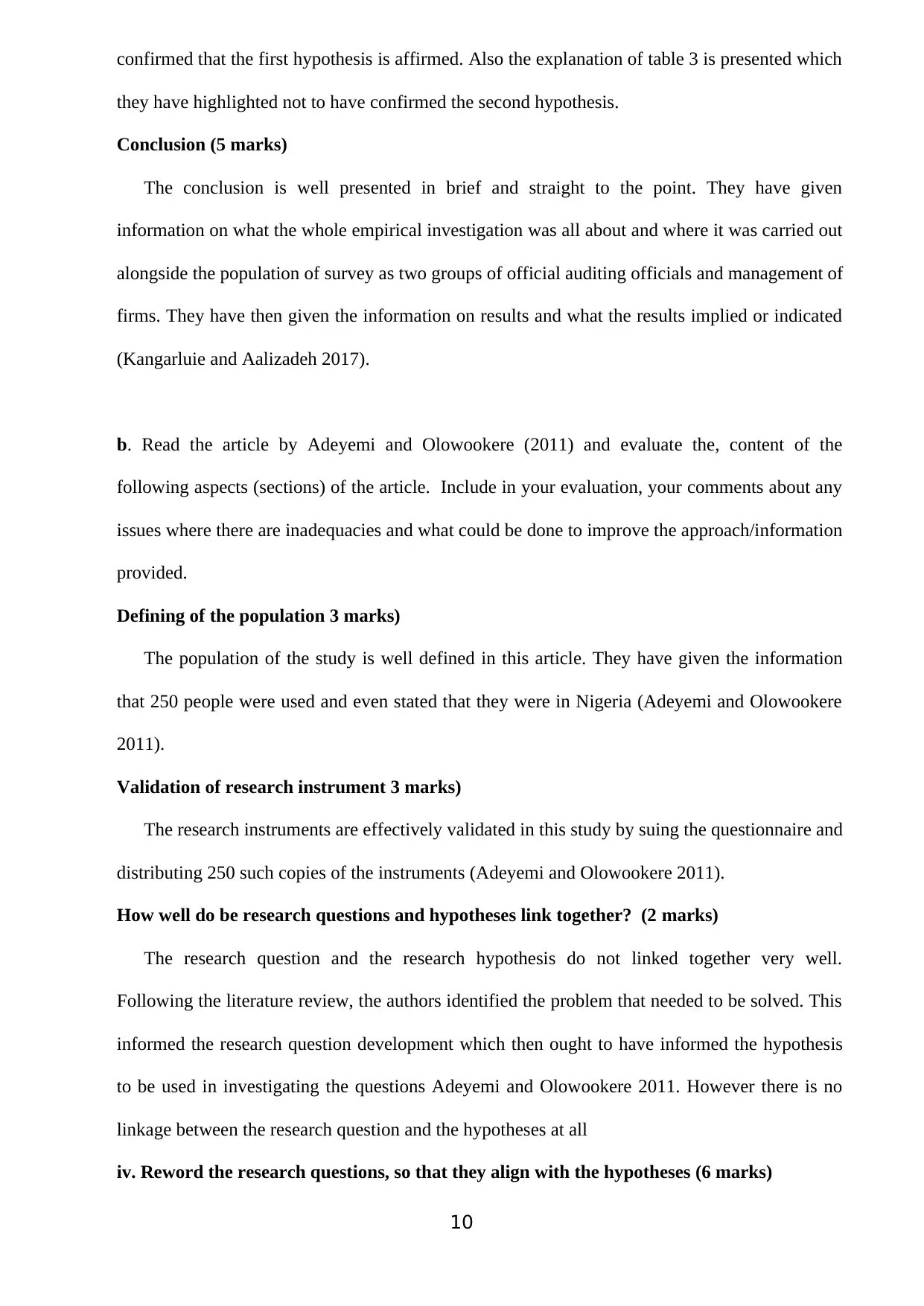
confirmed that the first hypothesis is affirmed. Also the explanation of table 3 is presented which
they have highlighted not to have confirmed the second hypothesis.
Conclusion (5 marks)
The conclusion is well presented in brief and straight to the point. They have given
information on what the whole empirical investigation was all about and where it was carried out
alongside the population of survey as two groups of official auditing officials and management of
firms. They have then given the information on results and what the results implied or indicated
(Kangarluie and Aalizadeh 2017).
b. Read the article by Adeyemi and Olowookere (2011) and evaluate the, content of the
following aspects (sections) of the article. Include in your evaluation, your comments about any
issues where there are inadequacies and what could be done to improve the approach/information
provided.
Defining of the population 3 marks)
The population of the study is well defined in this article. They have given the information
that 250 people were used and even stated that they were in Nigeria (Adeyemi and Olowookere
2011).
Validation of research instrument 3 marks)
The research instruments are effectively validated in this study by suing the questionnaire and
distributing 250 such copies of the instruments (Adeyemi and Olowookere 2011).
How well do be research questions and hypotheses link together? (2 marks)
The research question and the research hypothesis do not linked together very well.
Following the literature review, the authors identified the problem that needed to be solved. This
informed the research question development which then ought to have informed the hypothesis
to be used in investigating the questions Adeyemi and Olowookere 2011. However there is no
linkage between the research question and the hypotheses at all
iv. Reword the research questions, so that they align with the hypotheses (6 marks)
10
they have highlighted not to have confirmed the second hypothesis.
Conclusion (5 marks)
The conclusion is well presented in brief and straight to the point. They have given
information on what the whole empirical investigation was all about and where it was carried out
alongside the population of survey as two groups of official auditing officials and management of
firms. They have then given the information on results and what the results implied or indicated
(Kangarluie and Aalizadeh 2017).
b. Read the article by Adeyemi and Olowookere (2011) and evaluate the, content of the
following aspects (sections) of the article. Include in your evaluation, your comments about any
issues where there are inadequacies and what could be done to improve the approach/information
provided.
Defining of the population 3 marks)
The population of the study is well defined in this article. They have given the information
that 250 people were used and even stated that they were in Nigeria (Adeyemi and Olowookere
2011).
Validation of research instrument 3 marks)
The research instruments are effectively validated in this study by suing the questionnaire and
distributing 250 such copies of the instruments (Adeyemi and Olowookere 2011).
How well do be research questions and hypotheses link together? (2 marks)
The research question and the research hypothesis do not linked together very well.
Following the literature review, the authors identified the problem that needed to be solved. This
informed the research question development which then ought to have informed the hypothesis
to be used in investigating the questions Adeyemi and Olowookere 2011. However there is no
linkage between the research question and the hypotheses at all
iv. Reword the research questions, so that they align with the hypotheses (6 marks)
10
Paraphrase This Document
Need a fresh take? Get an instant paraphrase of this document with our AI Paraphraser
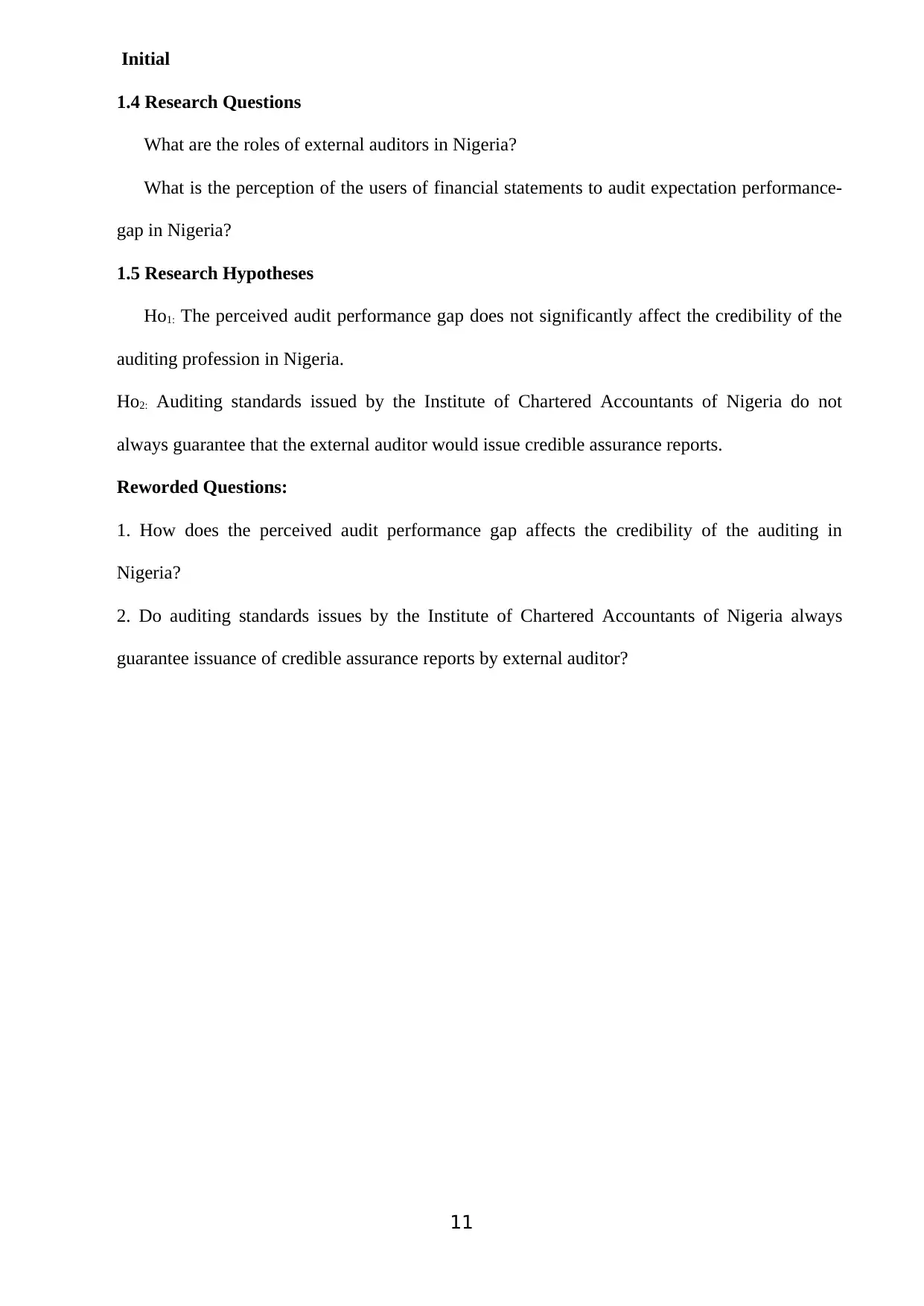
Initial
1.4 Research Questions
What are the roles of external auditors in Nigeria?
What is the perception of the users of financial statements to audit expectation performance-
gap in Nigeria?
1.5 Research Hypotheses
Ho1: The perceived audit performance gap does not significantly affect the credibility of the
auditing profession in Nigeria.
Ho2: Auditing standards issued by the Institute of Chartered Accountants of Nigeria do not
always guarantee that the external auditor would issue credible assurance reports.
Reworded Questions:
1. How does the perceived audit performance gap affects the credibility of the auditing in
Nigeria?
2. Do auditing standards issues by the Institute of Chartered Accountants of Nigeria always
guarantee issuance of credible assurance reports by external auditor?
11
1.4 Research Questions
What are the roles of external auditors in Nigeria?
What is the perception of the users of financial statements to audit expectation performance-
gap in Nigeria?
1.5 Research Hypotheses
Ho1: The perceived audit performance gap does not significantly affect the credibility of the
auditing profession in Nigeria.
Ho2: Auditing standards issued by the Institute of Chartered Accountants of Nigeria do not
always guarantee that the external auditor would issue credible assurance reports.
Reworded Questions:
1. How does the perceived audit performance gap affects the credibility of the auditing in
Nigeria?
2. Do auditing standards issues by the Institute of Chartered Accountants of Nigeria always
guarantee issuance of credible assurance reports by external auditor?
11
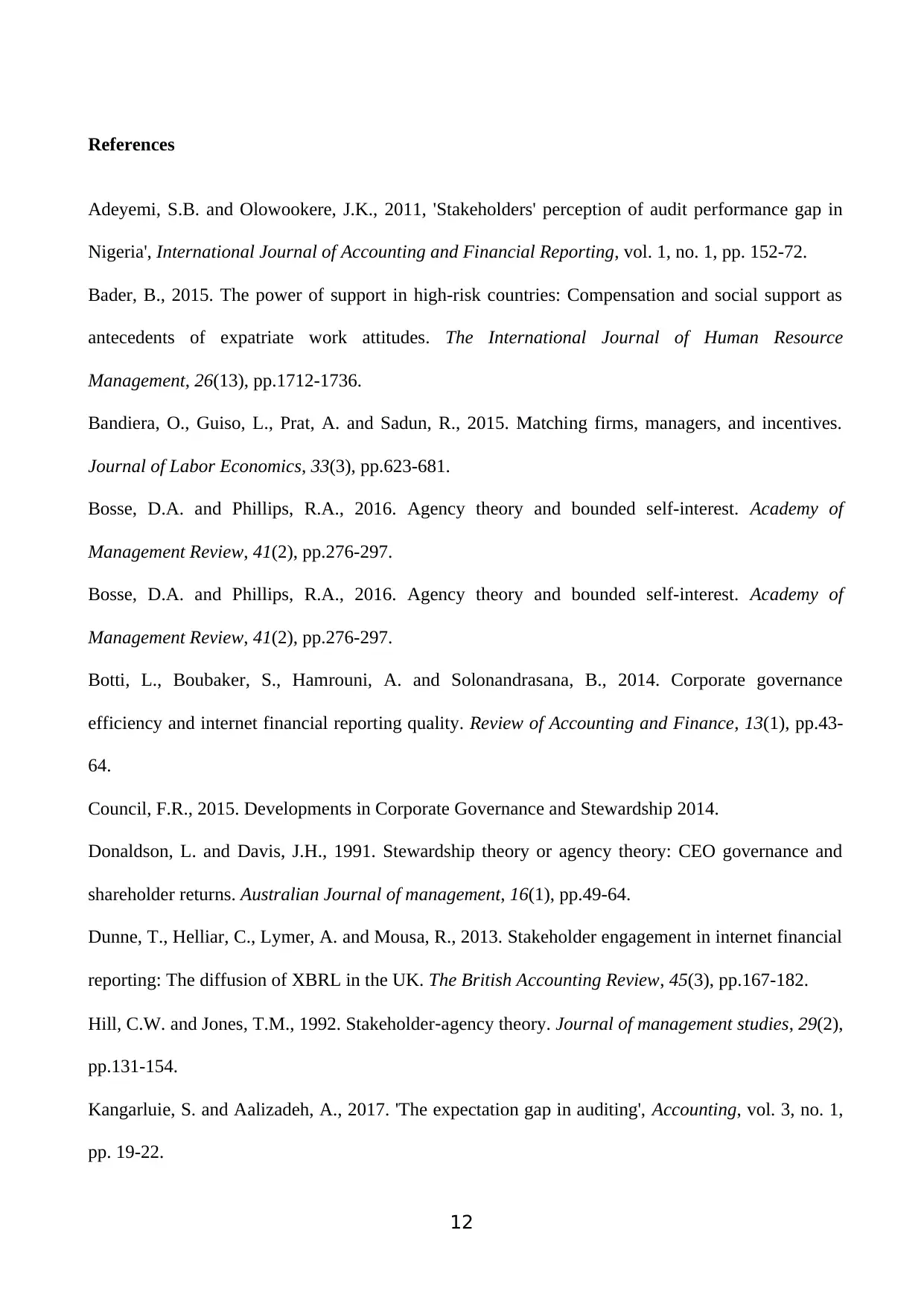
References
Adeyemi, S.B. and Olowookere, J.K., 2011, 'Stakeholders' perception of audit performance gap in
Nigeria', International Journal of Accounting and Financial Reporting, vol. 1, no. 1, pp. 152-72.
Bader, B., 2015. The power of support in high-risk countries: Compensation and social support as
antecedents of expatriate work attitudes. The International Journal of Human Resource
Management, 26(13), pp.1712-1736.
Bandiera, O., Guiso, L., Prat, A. and Sadun, R., 2015. Matching firms, managers, and incentives.
Journal of Labor Economics, 33(3), pp.623-681.
Bosse, D.A. and Phillips, R.A., 2016. Agency theory and bounded self-interest. Academy of
Management Review, 41(2), pp.276-297.
Bosse, D.A. and Phillips, R.A., 2016. Agency theory and bounded self-interest. Academy of
Management Review, 41(2), pp.276-297.
Botti, L., Boubaker, S., Hamrouni, A. and Solonandrasana, B., 2014. Corporate governance
efficiency and internet financial reporting quality. Review of Accounting and Finance, 13(1), pp.43-
64.
Council, F.R., 2015. Developments in Corporate Governance and Stewardship 2014.
Donaldson, L. and Davis, J.H., 1991. Stewardship theory or agency theory: CEO governance and
shareholder returns. Australian Journal of management, 16(1), pp.49-64.
Dunne, T., Helliar, C., Lymer, A. and Mousa, R., 2013. Stakeholder engagement in internet financial
reporting: The diffusion of XBRL in the UK. The British Accounting Review, 45(3), pp.167-182.
Hill, C.W. and Jones, T.M., 1992. Stakeholder‐agency theory. Journal of management studies, 29(2),
pp.131-154.
Kangarluie, S. and Aalizadeh, A., 2017. 'The expectation gap in auditing', Accounting, vol. 3, no. 1,
pp. 19-22.
12
Adeyemi, S.B. and Olowookere, J.K., 2011, 'Stakeholders' perception of audit performance gap in
Nigeria', International Journal of Accounting and Financial Reporting, vol. 1, no. 1, pp. 152-72.
Bader, B., 2015. The power of support in high-risk countries: Compensation and social support as
antecedents of expatriate work attitudes. The International Journal of Human Resource
Management, 26(13), pp.1712-1736.
Bandiera, O., Guiso, L., Prat, A. and Sadun, R., 2015. Matching firms, managers, and incentives.
Journal of Labor Economics, 33(3), pp.623-681.
Bosse, D.A. and Phillips, R.A., 2016. Agency theory and bounded self-interest. Academy of
Management Review, 41(2), pp.276-297.
Bosse, D.A. and Phillips, R.A., 2016. Agency theory and bounded self-interest. Academy of
Management Review, 41(2), pp.276-297.
Botti, L., Boubaker, S., Hamrouni, A. and Solonandrasana, B., 2014. Corporate governance
efficiency and internet financial reporting quality. Review of Accounting and Finance, 13(1), pp.43-
64.
Council, F.R., 2015. Developments in Corporate Governance and Stewardship 2014.
Donaldson, L. and Davis, J.H., 1991. Stewardship theory or agency theory: CEO governance and
shareholder returns. Australian Journal of management, 16(1), pp.49-64.
Dunne, T., Helliar, C., Lymer, A. and Mousa, R., 2013. Stakeholder engagement in internet financial
reporting: The diffusion of XBRL in the UK. The British Accounting Review, 45(3), pp.167-182.
Hill, C.W. and Jones, T.M., 1992. Stakeholder‐agency theory. Journal of management studies, 29(2),
pp.131-154.
Kangarluie, S. and Aalizadeh, A., 2017. 'The expectation gap in auditing', Accounting, vol. 3, no. 1,
pp. 19-22.
12
⊘ This is a preview!⊘
Do you want full access?
Subscribe today to unlock all pages.

Trusted by 1+ million students worldwide
1 out of 14
Related Documents
Your All-in-One AI-Powered Toolkit for Academic Success.
+13062052269
info@desklib.com
Available 24*7 on WhatsApp / Email
![[object Object]](/_next/static/media/star-bottom.7253800d.svg)
Unlock your academic potential
Copyright © 2020–2025 A2Z Services. All Rights Reserved. Developed and managed by ZUCOL.





